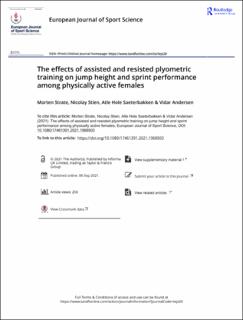| dc.contributor.author | Strate, Morten | |
| dc.contributor.author | Stien, Nicolay | |
| dc.contributor.author | Sæterbakken, Atle Hole | |
| dc.contributor.author | Andersen, Vidar | |
| dc.date.accessioned | 2021-09-30T11:02:32Z | |
| dc.date.available | 2021-09-30T11:02:32Z | |
| dc.date.created | 2021-09-16T13:07:53Z | |
| dc.date.issued | 2021 | |
| dc.identifier.citation | Strate, M., Stien, N., Saeterbakken, A. H., & Andersen, V. (2021). The effects of assisted and resisted plyometric training on jump height and sprint performance among physically active females. European Journal of Sport Science, 1-8 | en_US |
| dc.identifier.issn | 1746-1391 | |
| dc.identifier.uri | https://hdl.handle.net/11250/2786593 | |
| dc.description.abstract | The aim of the present study was to compare the effects of assisted and resisted plyometric jump training on jump height, sprint performance (acceleration (0–20m), maximum speed (30–40m) and 40m sprint time) among physically active females. Fifty-six participants (age: 21.1 ± 1.7 years; body mass: 64.2 ± 7.0 kg; height: 168.0 ± 5.6 cm) were randomly allocated to either an assisted (n = 16) or resisted training group (n = 17), or a control group (n = 14). Nine participants dropped out during the intervention. The training sessions consisted of three different plyometric jump exercises over an eight-week period, while the control group continued their normal training routine. The results revealed a significant between-group difference in jump height and maximal speed. The resisted training group achieved a significantly greater improvement in jump height compared to the active control group (p = .04, ES=1.06), and a significantly greater improvement in maximal speed (p = .02, ES = 0.93) when compared to the assisted training group. No other group differences were observed for jump height, acceleration or in maximal speed (p = .31–.53). The resisted training group improved jump height (p = .01, ES = 0.62) and maximum speed (p = .03, ES = 0.48) from pre- to post-test, while the control group improved maximal speed (p = .04, ES = 0.37) and acceleration (p = .01, ES = 0.68). All three groups improved their 40m sprint time from pre- to post-test (p = .01–.04, ES = 0.38–0.45). In conclusion, resisted plyometric training was more effective than assisted plyometric training for improving the maximal speed and more effective than the active control condition for increasing jump height. | en_US |
| dc.language.iso | eng | en_US |
| dc.publisher | Taylor & Francis | en_US |
| dc.rights | Attribution-NonCommercial-NoDerivatives 4.0 Internasjonal | * |
| dc.rights.uri | http://creativecommons.org/licenses/by-nc-nd/4.0/deed.no | * |
| dc.title | The effects of assisted and resisted plyometric training on jump height and sprint performance among physically active females | en_US |
| dc.type | Journal article | en_US |
| dc.type | Peer reviewed | en_US |
| dc.description.version | publishedVersion | en_US |
| dc.rights.holder | © 2021 The Author(s) | en_US |
| dc.subject.nsi | VDP::Social science: 200::Social science in sports: 330 | en_US |
| dc.source.journal | European Journal of Sport Science | en_US |
| dc.identifier.doi | 10.1080/17461391.2021.1968503 | |
| dc.identifier.cristin | 1934912 | |
| cristin.ispublished | true | |
| cristin.fulltext | original | |
| cristin.qualitycode | 1 | |

